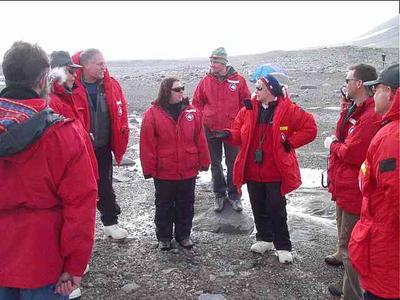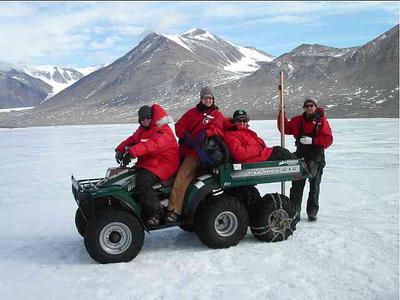
|
|
9 January, 2003
DV's in the DV's
Yesterday our team finally was completed. Daryl Morehead, a PI
(principal investigator) from the University of Toledo arrived. He is
joining us this year because Diane McKnight could not travel to the
Ice. So now there are seven of us.
We hustled around this morning cleaning F6 and getting our little
home shipshape because at 9:00 AM some "DVs" (Distinguished Visitors)
were arriving by helicopter in the DV's (Dry Valleys). Right on
time, the helo landed, and we introduced ourselves to Scott Borg,
National Science Foundation Program Director of Geological Science,
Kathy Olson, Associate Director of White House Office of Science and
Technology Policy, John Turner, Department of State Oceans and
Environmental Sciences Policy Issues, and Tom Weimer, Deputy
Assistant Director of Interior Water and Science. They were all very
interested in the work that we are doing, so we took them on a tour
of the gage on Von Guerard Stream which runs by our campsite. Each
person was able to explain their part of the work we are doing on the
streams, and I was able to tell them about the TEA program that has
brought me here. Pete explained why he is representing the USGS (US
Geological Survey). The USGS has established certain methods and
protocols for measuring data in the environment and reporting
results. Since our work in Antarctica is a US science program, the
USGS is here to be sure those protocols are followed, allowing
consistent reporting of data from all US programs.
Delta Stream
After our visitors left, we packed our gear and took the ATV down
to lower Delta Stream where we surveyed the transect and took our
algae and water samples. This is an interesting stream because it has
a huge wetted, or hyporheic, zone. The stream bed is wide with an
intricately braided channel, and there are seep zones where water
actually flows up out of the hyporheic zone and then into the stream
bed. Last year there were a lot of green algae in this stream, but
we found none. We think there may have been some dead green algae,
but we aren't sure. We found both orange and black algae, but it was
rather sparse.
We are getting faster at our jobs. I am no longer the "rodman."
Jenny is doing that job, and I am doing the surveying. She is still
the fastest pebble counter in the south, but I now am the fastest at
setting up "Theo" or surveying instrument. It usually takes me about
ten minutes, but I did it once in six and a half. I'm trying to beat
that record! Erin is taking the algae and water samples, and doing
the temperature and conductivity readings. We have slipped into a
comfortable routine.
In McMurdo there are a lot of "ops", short for operations. There
is MacOps, Helo Ops and so on. One night Karen and I got silly and
started saying we were doing "Night Ops" and "Special Ops" and "Photo
Ops." Then I suggested that our part of the Steam Team was "Algae
Ops," and that has now stuck. When we use the radios we say, "Stream
Team, this is Algae Ops. Do you have your ears on? Over." We also all
have radio nicknames using our first and last initials making foods.
Karen is Krispy Kreme, Jen is Jellybean, Pete is Pepperoni Stick,
Daryl is Dinty Moore, and I have been called "Lemon Head." (LH is
pretty hard to come up with a cute food name‚?"any ideas?) John
Gartner, too. We call him "Jimmy G".
It is getting more and more difficult to travel by ATV. The moats
are getting so wide, there are few places to walk across to get out
into the middle where the ice is thick and safe. I was on some today
that began cracking under me and scared me to death. Jen and Pete
both went in up to their knees today‚?"not scary but definitely
uncomfortable. Luckily it was very warm today. As a matter of fact,
it was so warm that at one point John was working without a shirt!
You may remember that our information told us that the Dry Valleys
have not had precipitation in millions of years. We are not sure
where that information came from because we have seen snow on several
occasions. There's not a lot, and there certainly hasn't been any
accumulation. To be more accurate we need to say "very little"
precipitation falls here.
I saw an amazing petrified seal today. Its whole lower jaw was
gone, but its tongue was still in its mouth, and you could even see
the bumps on its surface! The dryness here preserves the poor
animals that stumble into the Dry Valleys. It seems that they must
get disoriented and unable to find their way out again.
Tonight was a lot of fun. Pete and I cooked a huge dinner, and we
invited the lake coring team to F6 to enjoy it with us. Pete whipped
up a delicious lasagna, and I cooked pork tenderloin with my husband,
Terry's, famous bar-b-que sauce. (It was a hit, honey!) Mary Ann and
I worked on our journals for TEA together while everyone else
visited. There are nine of them and seven of us, so we had a house
full! There weren't quite enough plates and forks, but somehow we all
managed.
</P
 1. Jen explains the work of "Algae Ops" to our
1. Jen explains the work of "Algae Ops" to our
distinguished visitors. From the left: Daryl Morehead, John Turner,
Scott Borg, Jen Baeseman, John Gartner, Kathy Olson, Pete Spatz and
Tom Weimer.

2. Algae Ops on the move in the ATV. Jen, Erin,
Louise, and Pete

3. Seal skeleton with the tongue preserved.

4. John working on the ice without a shirt. Yes, I
really am in Antarctica!
Contact the TEA in the field at
.
If you cannot connect through your browser, copy the
TEA's e-mail address in the "To:" line of
your favorite e-mail package.
|
